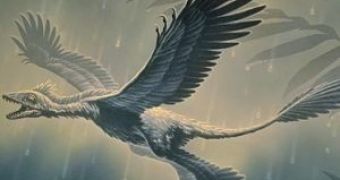The earliest birds started flying by gliding from tree to tree using primitive feathered wings on their arms and legs, according to new research by a University of Calgary paleontologist.
PhD student Nick Longrich rejects the idea that birds began flying by taking off from the ground while running and shows that the dinosaur-like bird Archaeopteryx floated through the air using wing-like feathers on all of its limbs. "The discussions about the origins of avian flight have been dominated by the so-called 'ground up' and 'trees down' hypotheses," Longrich said. "This paper puts forward some of the strongest evidence yet that birds descended from arboreal parachuters and gliders, similar to modern flying squirrels."
The fossils of the oldest avian species, Archaeopteryx lithographica, is the best evidence that birds evolved from small theropod dinosaurs, mixing avian traits (feathers, bird-like wishbone) and reptilian features (a long bony tail, claws and teeth).
Scientists always looked at the hind-limbs feathers as insulating, playing no role in the animal's flight. But in 2002 several four-winged dinosaurs were described in China. Small Chinese dinosaurs - called Microraptor (image) and Pedopenna - used a two-level, biplane wing configuration to fly from tree to tree in the early Cretaceous. "Microraptor had unmistakable flight feathers on its hind limbs as well as on its wings", says paleontologist Sankar Chatterjee, a distinguished professor at Texas Tech University in Lubbock.
"It is intriguing to contemplate that perhaps avian flight, like aircraft evolution, went through a biplane stage before the monoplane was introduced," said Chatterjee.
"The most unusual thing is that they have flight feathers not only on the hand section, but also on foot".
The Chinese paleontologists thought its four wings were used in tandem, like in a dragonfly. But Microraptor had reptilian hind limbs, permitting forward and backward motion. "The problem we faced is that the legs of Microraptor, like on any dinosaur, could not be splayed sideways. That means Microraptor could not have extended its rear limbs to form a wing directly behind the front wing. More likely, and more aerodynamically stable, would have been a rear wing that was held lower than the front wing -- what from the side would look like a staggered biplane configuration", Chatterjee explains.
Computer simulation and aeronautical analysis showed Microraptor launched from a high branch and dove off, falling head-first, until it reached a speed that created lift on its wings. After that, the small dinosaur landed in another branch without moving its wings and saving energy. "These fossils show various transitional stages -- from wingless, tree-dwelling theropod dinosaurs to fully winged, active flyers", Chatterjee said.
In the trees-down theory, gravity was the source of energy: a small tree dinosaur first parachuted down, then glided, and finally acquired powered flight. Feathers became larger and more specialized with the development of flight ability. In contrast, the ground-up theory has a theropod jumping toward flight directly from the ground, against gravity, without any gliding stage. "Such long feathers around the feet would make it hard for Microraptor to run on the ground", says Chatterjee, reinforcing the trees-down theory.
These discoveries from China determined the scientists to re-examine Archaeopteryx's legs. "The idea of a multi-winged Archaeopteryx has been around for more than a century, but it hasn't received much attention," Longrich said.
"I believe one reason for this is that people tend to see what they want or expect to see. Everybody knows that birds don't have four wings, so we overlooked them even when they were right under our noses."
Longrich examined Archaeopteryx fossils and determined that the dinosaur's leg feathers have an aerodynamic structure that meant its hind limbs likely acted as "winglets" that played a role in flight.

 14 DAY TRIAL //
14 DAY TRIAL //